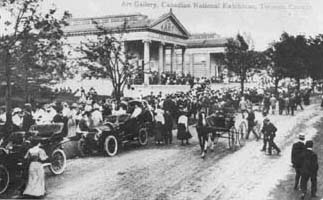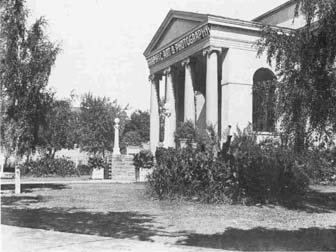
Bulletin 22, 1973
Home
Français
Introduction
History
Annual Index
Author &
Subject
Credits
Contact



Foreign
Art at the Canadian National Exhibition 1905-1938
by Sybille Pantazzi
Pages 1 | 2
| 3
| 4
| 5
| 6
| 7
| 8
| 9
| 10 | 11
By 1905, the defects of
this gallery had become only too obvious. Apart from the fact that
it was built with inflammable materials (as pointed out by the O. S.
A.
at the time), it had "grave faults in lighting, ventilation,
etc.," was small and, having only one entrance, was not planned
to accommodate or encourage the circulation of vast crowds. In
fact complete deadlocks often occurred, and the doors of the
gallery had to be temporarily closed. (7)
Plans for a second and larger gallery of brick and other
"fire-proof" materials were drawn up by a Select Commit
tee of the O. S. A. (R. F. Gagen, F. S. Challener, and F. M.
Bell-Smith), and the construction was entrusted to the architect
of the C. N. E. Association. George W.Gouinlock. (8) Its cost was $
42,000. (9) The influence of the Chicago World's Fair is still visible
in the more monumental style of the new gallery: each pavilion was
again fronted by a classical portico, higher than before, and once
again supported by four unfluted Ionic columns. The symmetrical
U-shaped plan, consisting of two pavilions linked by an exhibition
gallery, ensured that "the crowd would be able to pass
continuously through." The west porch was used as the entrance,
and the east porch was used as the exit. The building was provided
with sky-lights (Beaux-Arts versions of factory monitors) and contained five galleries
- two in each pavilion and one large central one. (10) The aim and aspirations of the Gallery of 1905 were
symbolically proclaimed in the traditional manner by inscribing
around the building (on tablets placed under the entablature) the
names of thirty-six foreign artists ranging from Giotto to Gérome
(fig. 4).
Exhibitions of works by Canadian artists, both professional and
amateur, had been held at the Toronto Industrial Exhibition ever
since its incorporation in 1879, but the erection in 1905 of an
adequate, "fire-proof" gallery and the funds provided by
the C. N. E. Association rendered possible, for the first time, the
exhibition on an important scale of foreign art in Toronto. The
proportion of one-third Canadian to two-thirds foreign (11) seems to
have been maintained from about 1907 (except in 1920 and 1930, when
Canadian art only was shown).
The gallery of 1902 was later used for the exhibition of Applied and
Graphic Arts and was referred to by both these names (fig. 5),
whereas the gallery of 1905 was known as the Fine Art Building or,
simply, the Art Gallery. By 1914, the Annual Report of the O.
S. A. stated that the enlargement of the gallery of 1905 was a
pressing necessity; but its original size remained unaltered
until its demolition in 1973. (12) A detailed description has been
given of the two art galleries at the C. N. E. and, in particular, of
the one built in 1905 in order to emphasize that, owing to the
availability of two buildings, the scope and importance of the international exhibitions held at the
C. N. E. were, for twenty
years (1906-1926), on a larger scale than those held at the Art
Museum of Toronto. The latter was incorporated in 1900 but did not
take possession of The Grange until 1912, so that, although three
new galleries were added in 1918, it was not able to fulfill its
role adequately until after 1926 when its new building - comprising
six additional galleries - was inaugurated. (13)
An idea of how the C. N. E. Exhibition Committees dealt with the
increasing size of the exhibitions in the 1920s and 1930s, and a
description of the installation in the Fine Art Building during
those decades, can be gleaned from the comments of the local press.
In August 1927, M. O. Hammond considered it attractive but
out-of-date as well as inadequate. He mentions that the Gallery
had been extended at the rear in order to hang etchings and small
pictures. (14) Ten years later, Pearl McCarthy noted that the prints,
which had been moved over to the Graphic Arts Building, "look
much better than they did in the alcoves of the annex to the main
gallery." (15) In 1935 the same critic described the improved
installation in the Art Gallery as follows: "the walls have
been hung with oyster shade burlap, and new material has been used
for the light screens under the roof windows. The whole effect is
one of softly diffused, yet adequate brightness, which is most
agreeable." (16)
The management of the art exhibitions was shared by the C. N. E.
Association and the Ontario Society of Artists. The influence
of the O. S. A. (founded in 1872) was preponderant even after 1911,
when the Presidents of the Royal Canadian Academy of Arts and of
the Canadian Art Club were added to the Hanging Committee (fig. 6)
which consisted of three members of the first-named society. (17) It
was maintained because the artist, Robert F. Gagen, Secretary of
the O. S. A. since 1889, was appointed Director of the Fine Art
Exhibitions in 1904, and Secretary of the Commission in 1912. He
occupied both these posts until his death in 1926. In 1920, F .S.
Haines, the painter and etcher, was appointed secretary of the
Department of Graphic Art and in 1924, commissioner. He ably and
energetically held this key post until 1951, and was responsible for
many of the exhibitions, in particular those of Graphic Art held in
the late 1920S and 1930s. In 1927, for example, he went abroad to
select pictures.
The aims of the artists and the aims of the C. N. E. Association did
not always coincide. The artists' main objective was art education
and cultivation of the public; the C. N. E. Association's main
objective was the exhibition of "sensational" works which
would at tract crowds and increase the attendance and receipts.
The influence of the C. N. E. Association Manager was an important
one, and it was fortunate that Dr J. O. Orr, the manager from 1903 to
1917, encouraged his directors to make large appropriations to
import works from abroad and to make grants for purchases. (18) The
foreign representatives or agents for the collection of British and
foreign art were also chosen by the C. N. E. Association and acted on
suggestions received from the Commission.
The first of these agents was Alfred George Temple, F. S. A. (1848 -
c.
1927), Director of the Guildhall Art Gallery in London. He was
succeeded in 1912 by E. Rimbault Dibdin (1853-1941), curator of the
Walker Art Gallery in Liverpool, who remained the European
representative until 1933-1934. In 1935 Dibdin was replaced by
Charles Robert Chisman (active 1911-1948), another Englishman,
founder and governing director of the Art Exhibitions Bureau, of
which Dibdin had been consulting director. Chisman, who was a
pioneer of the principle of circulating exhibitions, continued as
European representative until the early 1940s.
From the beginning, the policy of the O. S. A. was to Show "the
best modern pictures" at the C. N. E., as these exhibitions
provided a needed opportunity to compare current Canadian art with
that produced elsewhere. (19) The purpose was also to educate the
taste of the general public, to enlarge the horizon of local
artists, and to inspire potential artists. Even before the second
gallery was built, several large historical and religious pictures by
living European artists were borrowed from Sir George Drummond in
Montreal: Benjamin Constant's Moorish Conqueror Surveying the
Spoils of a Christian City, Karl Von Piloty's The Last
Moments of the Girondists, and Gabriel Max's The Raising of
Jairus' Daughter. (20) All three pictures were illustrated in the
catalogue. (Both Constant and Von piloty were among the artists
represented in the recent Salon imaginaire [Berlin, 1968].
(21) In the same year, 1904, the replica of Benjamin West's The Death
of Wolfe from the Royal Collection was also included in the
exhibition.
Next Page | New York dealers
1 | 2
| 3
| 4
| 5
| 6
| 7
| 8
| 9
| 10 | 11
Annual Index | Author & Subject | Credits | Contact
This digital collection
was produced under contract to Canada's Digital Collections program,
Industry Canada.
"Digital
Collections Program, Copyright
© National Gallery of
Canada 2001"